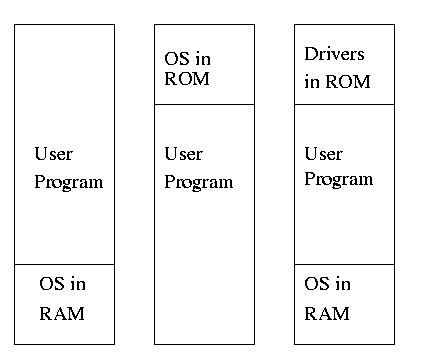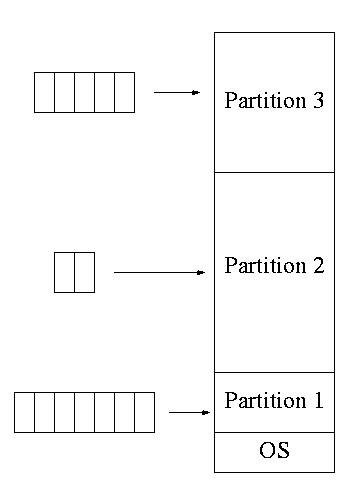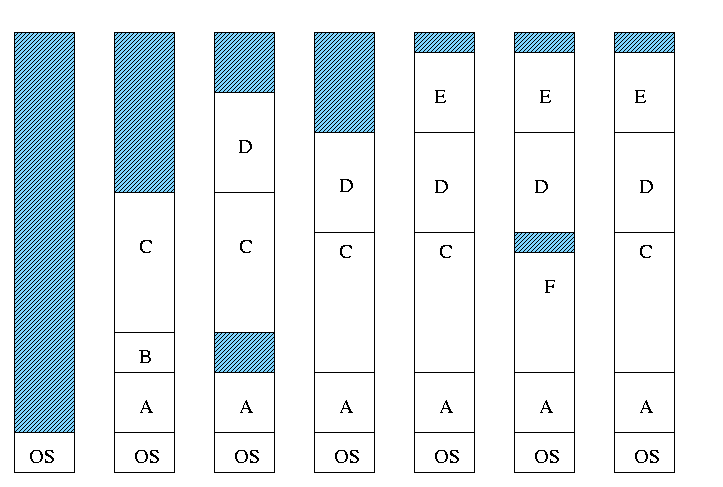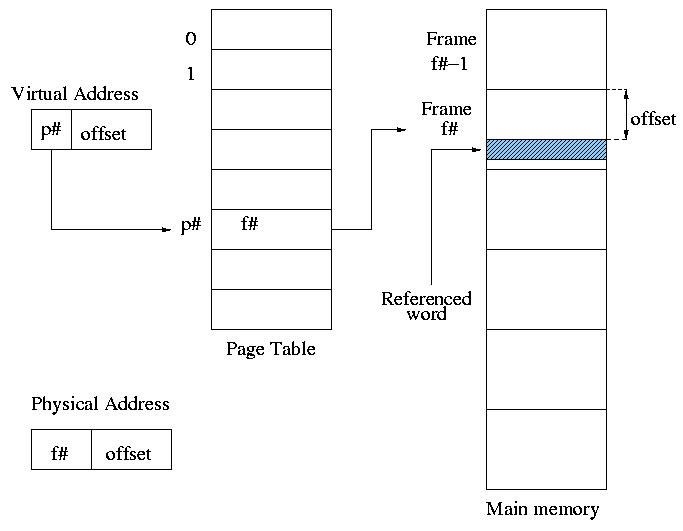Operating Systems
2000-01 Fall
M 5:00-6:50
Ciww 109
Allan Gottlieb
gottlieb@nyu.edu
http://allan.ultra.nyu.edu/~gottlieb
715 Broadway, Room 1001
212-998-3344
609-951-2707
email is best
================ Start Lecture #5
================
Chapter 3: Memory Management
Also called storage management or
space management.
Memory management must deal with the storage
hierarchy present in modern machines.
- Registers, cache, central memory, disk, tape (backup)
- Move data from level to level of the hierarchy.
- How should we decide when to move data up to a higher level?
- Fetch on demand (e.g. demand paging, which is dominant now).
- Prefetch
- Read-ahead for file I/O.
- Large cache lines and pages.
- Extreme example. Entire job present whenever running.
We will see in the next few lectures that there are three independent
decision:
- Segmentation (or no segmentation)
- Paging (or no paging)
- Fetch on demand (or no fetching on demand)
Memory management implements address translation.
- Convert virtual addresses to physical addresses
- Also called logical to real address translation.
- A virtual address is the address expressed in
the program.
- A physical address is the address understood
by the computer.
- The translation from virtual to physical addresses is performed by
the Memory Management Unit or (MMU).
- Another example of address translation is the conversion of
relative addresses to absolute addresses by the linker.
- The translation might be trivial (e.g., the identity) but not in a modern
general purpose OS.
- The translation might be difficult (i.e., slow).
- Often includes addition/shifts/mask--not too bad.
- Often includes memory references.
- VERY serious.
- Solution is to cache translations in a Translation
Lookaside Buffer (TLB). Sometimes called a
translation buffer (TB).
Homework: 7.
When is address translation performed?
- At compile time
- Primitive.
- Compiler generates physical addresses.
- Requires knowledge of where the compilation unit will be loaded.
- Rarely used (MSDOS .COM files).
- At link-edit time (the ``linker lab'')
- Compiler
- Generates relocatable addresses for each compilation unit.
- References external addresses.
- Linkage editor
- Converts the relocatable addr to absolute.
- Resolves external references.
- Misnamed ld by unix.
- Also converts virtual to physical addresses by knowing where the
linked program will be loaded. Linker lab ``does'' this, but
it is trivial since we assume the linked program will be
loaded at 0.
- Loader is simple.
- Hardware requirements are small.
- A program can be loaded only where specified and
cannot move once loaded.
- Not used much any more.
- At load time
- Similar to at link-edit time, but do not fix
the starting address.
- Program can be loaded anywhere.
- Program can move but cannot be split.
- Need modest hardware: base/limit registers.
- Loader sets the base/limit registers.
- At execution time
- Addresses translated dynamically during execution.
- Hardware needed to perform the virtual to physical address
translation quickly.
- Currently dominates.
- Much more information later.
Extensions
- Dynamic Loading
- When executing a call, check if module is loaded.
- If not loaded, call linking loader to load it and update
tables.
- Slows down calls (indirection) unless you rewrite code
dynamically.
- Not used much.
- Dynamic Linking
- The traditional linking described above is today often called
static linking.
- With dynamic linking, frequently used routines are not linked
into the program. Instead, just a stub is linked.
- When the routine is called, the stub checks to see if the
real routine is loaded (it may have been loaded by
another program).
- If not loaded, load it.
- If already loaded, share it. This needs some OS
help so that different jobs sharing the library don't
overwrite each other's private memory.
- Advantages of dynamic linking.
- Saves space: Routine only in memory once even when used
many times.
- Bug fix to dynamically linked library fixes all applications
that use that library, without having to
relink the application.
- Disadvantages of dynamic linking.
- New bugs in dynamically linked library infect all
applications.
- Applications ``change'' even when they haven't changed.
Note: I will place ** before each memory management
scheme.
3.1: Memory management without swapping or paging
Entire process remains in memory from start to finish.
The sum of the memory requirements of all jobs in the system cannot
exceed the size of physical memory.
** 3.1.1: Monoprogramming without swapping or paging (Single User)
The ``good old days'' when everything was easy.

- No address translation done by the OS (i.e., address translation is
not performed dynamically during execution).
- Either reload the OS for each job (or don't have an OS, which is almost
the same), or protect the OS from the job.
- One way to protect (part of) the OS is to have it in ROM.
- Of course, must have the data in ram.
- Can have a separate OS address space only accessible in
supervisor mode.
- Might just put some drivers in ROM (BIOS).
- The user employs overlays if the memory needed
by a job exceeds the size of physical memory.
- Programmer breaks program into pieces.
- A ``root'' piece is always memory resident.
- The root contains calls to load and unload various pieces.
- Programmer's responsibility to ensure that a piece is already
loaded when it is called.
- No longer used, but we couldn't have gotten to the moon in the
60s without it (I think).
- Overlays have been replaced by dynamic address translation and
other features (e.g., demand paging) that have the system support
logical address sizes greater than physical address sizes.
- Fred Brooks (leader of IBM's OS/360 project and author of ``The
mythical man month'') remarked that the OS/360 linkage editor was
terrific, especially in its support for overlays, but by the time
it came out, overlays were no longer used.
3.1.2: Multiprogramming and Memory Usage
Goal is to improve CPU utilization, by overlapping CPU and I/O
- Consider a job that is unable to compute (i.e., it is waiting for
I/O) a fraction p of the time.
- Then, with monoprogramming, the CPU utilization is 1-p.
- Note that p is often > .5 so CPU utilization is poor.
- But, if the probability that a
job is waiting for I/O is p and n jobs are in memory, then the
probability that all n are waiting for I/O is approximately p^n.
- So, with a multiprogramming level (MPL) of n,
the CPU utilization is approximately 1-p^n.
- If p=.5 and n=4, then 1-p^n = 15/16, which is much better than
1/2, which would occur for monoprogramming (n=1).
- This is a crude model, but it is correct that increasing MPL does
increase CPU utilization up to a point.
- The limitation is memory, which is why we discuss it here
instead of process management. That is, we must have many jobs
loaded at once, which means we must have enough memory for them
There are other issues as well and we will discuss them.
- Some of the CPU utilization is time spent in the OS executing
context switches so the gains are not a great as the crude model predicts.
Homework: 1, 3.
3.1.3: Multiprogramming with fixed partitions

- This was used by IBM for system 360 OS/MFT (multiprogramming with a
fixed number of tasks).
- Can have a single input queue instead of one for each partition.
- So that if there are no big jobs can use big partition for
little jobs.
- But I don't think IBM did this.
- Can think of the input queue(s) as the ready list(s) with a
scheduling policy of FCFS in each partition.
- The partition boundaries are not movable (must reboot to
move a job).
- MFT can have large internal fragmentation,
i.e., wasted space inside a region
- Each process has a single ``segment'' (we will discuss segments later)
- No sharing between process.
- No dynamic address translation.
- At load time must ``establish addressability''.
- i.e. must set a base register to the location at which the
process was loaded (the bottom of the partition).
- The base register is part of the programmer visible register set.
- This is an example of address translation during load time.
- Also called relocation.
- Storage keys are adequate for protection (IBM method).
- Alternative protection method is base/limit registers.
- An advantage of base/limit is that it is easier to move a job.
- But MFT didn't move jobs so this disadvantage of storage keys is moot.
- Tanenbaum says jobs were ``run to completion''. This must be
wrong as that would mean monoprogramming.
- He probably means that jobs not swapped out and each queue is FCFS
without preemption.
3.2: Swapping
Moving entire processes between disk and memory is called
swapping.
3.2.1: Multiprogramming with variable partitions
- Both the number and size of the partitions change with time.
- IBM OS/MVT (multiprogramming with a varying number of tasks).
- Also early PDP-10 OS.
- Job still has only one segment (as with MFT) but now can be of any
size up to the size of the machine and can change with time.
- A single ready list.
- Job can move (might be swapped back in a different place).
- This is dynamic address translation (during run time).
- Must perform an addition on every memory reference (i.e. on every
address translation) to add the start address of the partition.
- Called a DAT (dynamic address translation) box by IBM.
- Eliminates internal fragmentation.
- Find a region the exact right size (leave a hole for the
remainder).
- Not quite true, can't get a piece with 10A755 bytes. Would
get say 10A760. But internal fragmentation is much
reduced compared to MFT. Indeed, we say that internal
fragmentation has been eliminated.
- Introduces external fragmentation, i.e., holes
outside any region.
- What do you do if no hole is big enough for the request?
- Can compactify
- Transition from bar 3 to bar 4 in diagram below.
- This is expensive.
- Not suitable for real time (MIT ping pong).
- Can swap out one process to bring in another
- Bars 5-6 and 6-7 in diagram

Homework: 4
- There are more processes than holes. Why?
- Because next to a process there might be a process or a hole
but next to a hole there must be a process
- So can have ``runs'' of processes but not of holes
- Above actually shows that there are about twice as many
processes as holes.
- Base and limit registers are used
- Storage keys not good since compactifying would require
changing many keys.
- Storage keys might need a fine granularity to permit the
boundaries move by small amounts. Hence many keys would need to be
changed
MVT Introduces the ``Placement Question'', which hole (partition)
to choose
- Best fit, worst fit, first fit, circular first fit, quick fit, Buddy
- Best fit doesn't waste big holes, but does leave slivers and
is expensive to run.
- Worst fit avoids slivers, but eliminates all big holes so a
big job will require compaction. Even more expensive than best
fit (best fit stops if it finds a perfect fit).
- Quick fit keeps lists of some common sizes (but has other
problems, see Tanenbaum).
- Buddy system
- Round request to next highest power of two (causes
internal fragmentation).
- Look in list of blocks this size (as with quick fit).
- If list empty, go higher and split into buddies.
- When returning coalesce with buddy.
- Do splitting and coalescing recursively, i.e. keep
coalescing until can't and keep splitting until successful.
- See Tanenbaum for more details (or an algorithms book).
- A current favorite is circular first fit (also know as next fit)
- Use the first hole that is big enough (first fit) but start
looking where you left off last time.
- Doesn't waste time constantly trying to use small holes that
have failed before, but does tend to use many of the big holes,
which can be a problem.
- Buddy comes with its own implementation. How about the others?
- Bit map
- Only question is how much memory does one bit represent.
- Big: Serious internal fragmentation
- Small: Many bits to store and process
- Linked list
- Each item on list says whether Hole or Process, length,
starting location
- The items on the list are not taken from the memory to be
used by processes
- Keep in order of starting address
- Double linked
- Boundary tag
- Knuth
- Use the same memory for list items as for processes
- Don't need an entry in linked list for blocks in use, just
the avail blocks are linked
- For the blocks currently in use, just need a hole/process bit at
each end and the length. Keep this in the block itself.
- See knuth, the art of computer programming vol 1
Homework: 2, 5.
MVT Also introduces the ``Replacement Question'', which victim to
swap out
We will study this question more when we discuss
demand paging
Considerations in choosing a victim
- Cannot replace a job that is pinned,
i.e. whose memory is tied down. For example, if Direct Memory
Access (DMA) I/O is scheduled for this process, the job is pinned
until the DMA is complete.
- Victim selection is a medium term scheduling decision
- Job that has been in a wait state for a long time is a good candidate.
- Often choose as a victim a job that has been in memory for a long
time.
- Another point is how long should it stay swapped out.
- For demand paging, where swaping out a page is not as drastic as
swapping out a job, choosing the victim is an important memory
management decision and we shall study several policies,
NOTEs:
- So far the schemes presented have had two properties:
- Each job is stored contiguously in memory. That is, the job is
contiguous in physical addresses.
- Each job cannot use more memory than exists in the system. That
is, the virtual addresses space cannot exceed the physical address
space.
- Tanenbaum now attacks the second item. I wish to do both and start
with the first
- Tanenbaum (and most of the world) uses the term ``paging'' to mean
what I call demand paging. This is unfortunate as it mixes together
two concepts
- Paging (dicing the address space) to solve the placement
problem and essentially eliminate external fragmentation.
- Demand fetching, to permit the total memory requirements of
all loaded jobs to exceed the size of physical memory.
- Tanenbaum (and most of the world) uses the term virtual memory as
a synonym for demand paging. Again I consider this unfortunate.
- Demand paging is a fine term and is quite descriptive
- Virtual memory ``should'' be used in contrast with physical
memory to describe any virtual to physical address translation.
** (non-demand) Paging
Simplest scheme to remove the requirement of contiguous physical
memory.
- Chop the program into fixed size pieces called
pages (invisible to the programmer).
- Chop the real memory into fixed size pieces called page
frames or simply frames.
- Size of a page (the page size) = size of a frame (the frame size).
- Sprinkle the pages into the frames.
- Keep a table (called the page table) having an
entry for each page. The page table entry or PTE for
page p contains the number of the frame f that contains page p.

Example: Assume a decimal machine with
page size = frame size = 1000.
Assume PTE 3 contains 459.
Then virtual address 3372 corresponds to physical address 459372.
Properties of (non-demand) paging.
- Entire job must be memory resident to run.
- No holes, i.e. no external fragmentation.
- If there are 50 frames available and the page size is 4KB than a
job requiring <= 200KB will fit, even if the available frames are
scattered over memory.
- Hence (non-demand) paging is useful.
- Introduces internal fragmentation approximately equal to 1/2 the
page size for every process (really every segment).
- Can have a job unable to run due to insufficient memory and
have some (but not enough) memory available. This is not
called external fragmentation since it is not due to memory being fragmented.
- Eliminates the placement question. All pages are equally
good since don't have external fragmentation.
- Replacement question remains.
- Since page boundaries occur at ``random'' points and can change from
run to run (the page size can change with no effect on the
program--other than performance), pages are not appropriate units of
memory to use for protection and sharing. This is discussed further
when we introduce segmentation.
Homework: 13




